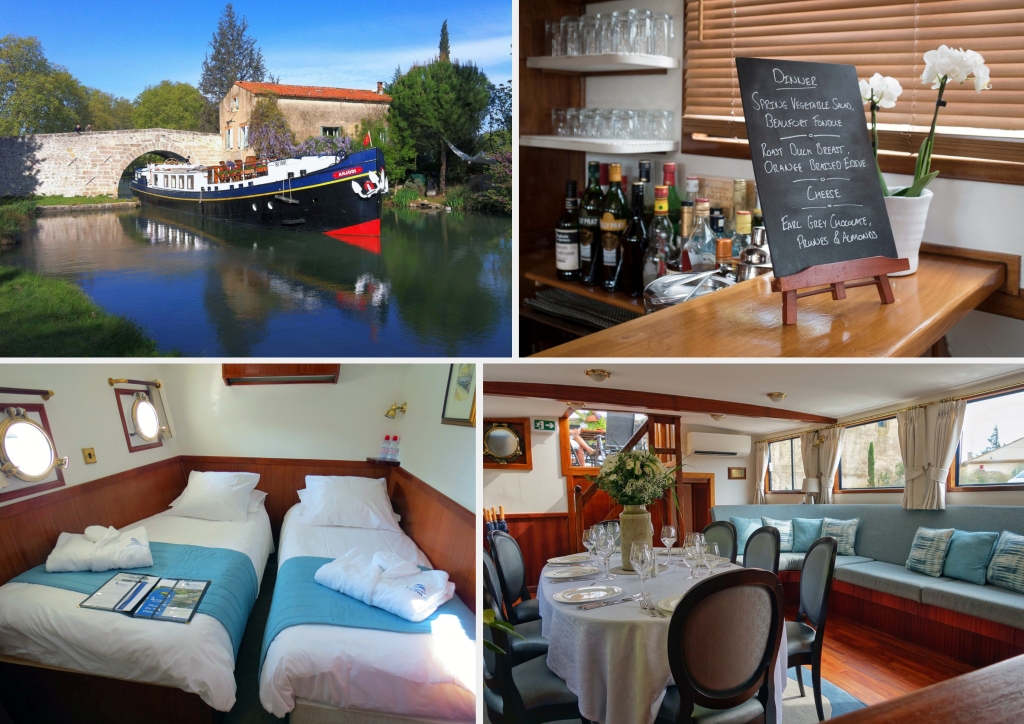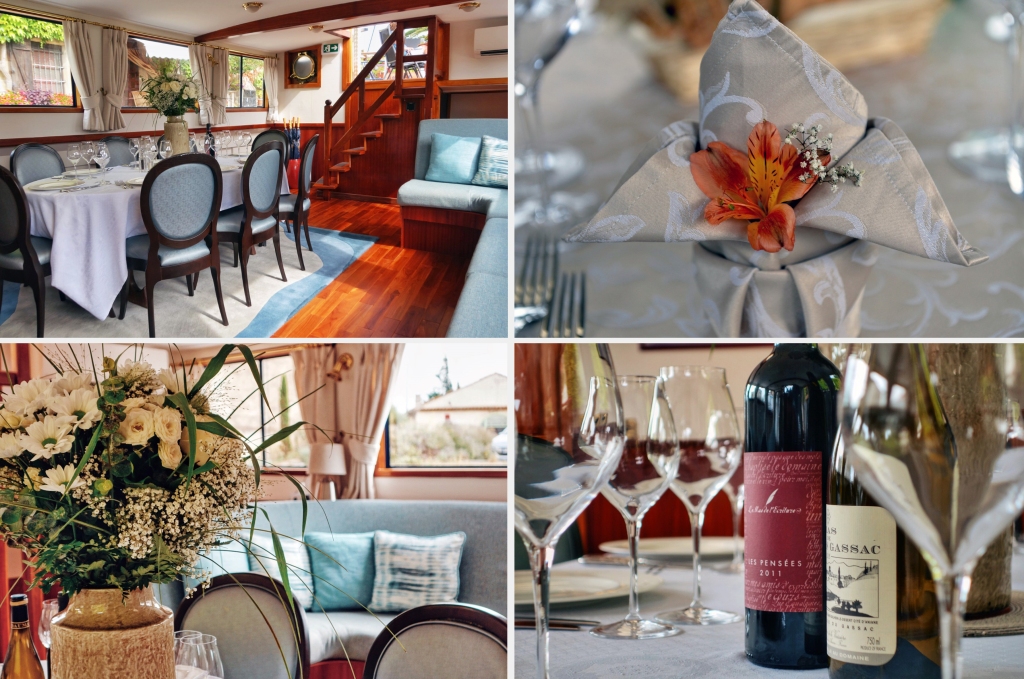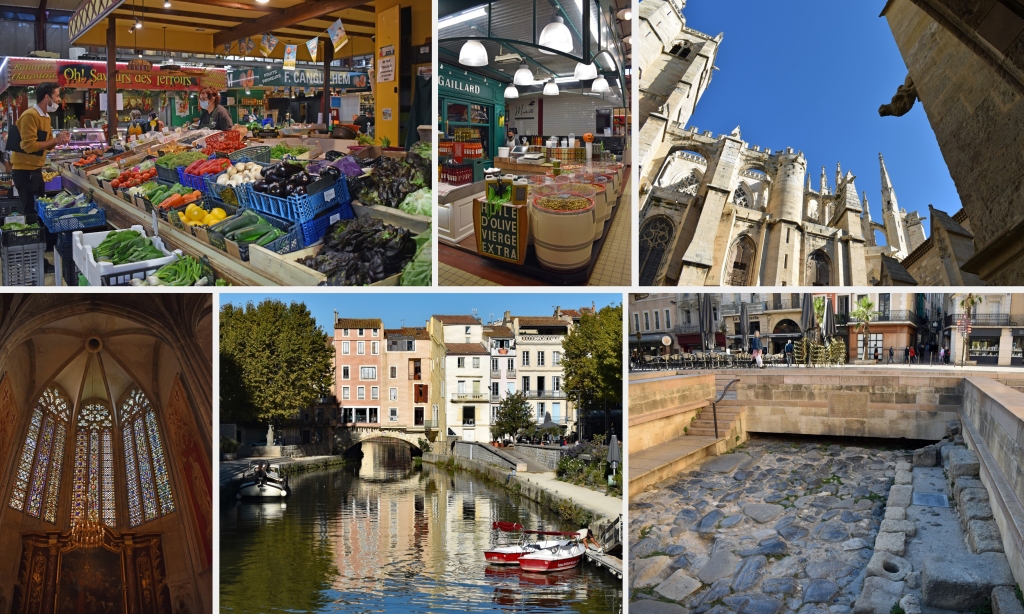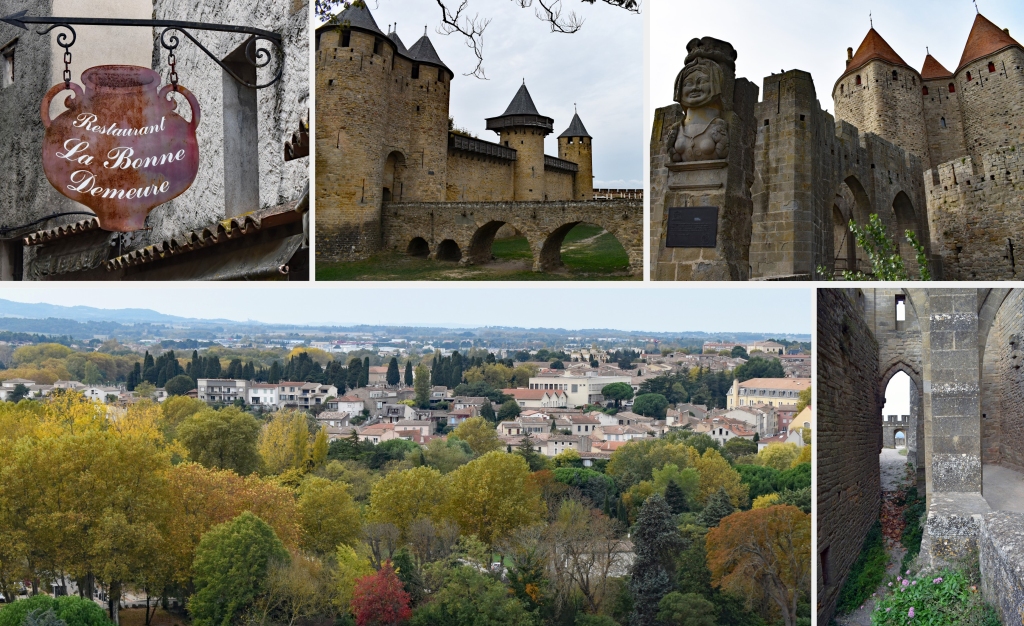Fall has always been my favorite season. I love the crisp cool air, the sound of fallen leaves crunching under my feet, and most of all the glorious display of colors. After being grounded from travelling for almost two years due to the pandemic, we couldn’t think of a better way to restart our adventures than by taking a barge trip to see the fall colors in France. This was our second barge trip with European Waterways, so we knew we’d be treated like royalty. For our first trip, we toured the Caledonian Canal in Scotland. This time, we choose a trip on the Canal du Midi in Southern France on the barge Anjodi. At 100 feet (30.5 meters) long, Anjodi holds eight passengers and four crew. Built in the Netherlands in 1929, she was originally a trading barge. In 1963, the owner Tiemen de Weerd named her after his three children: Andries, Johan, and Diana. She was featured on the popular BBC TV series French Odyssey with British Chef Rick Stein in 2007.

We met our fellow passengers at a hotel in Narbonne while we waited for the van to pick us up. There were seven of us: Rick and I, a couple from Sequim Washington, a couple from Toronto, and a single gentleman from New York City. We all love travel, fine food and wine, and meeting new people so I knew we’d have a wonderful week together on the barge. Captain Laurent (France) met us at the hotel and drove us to meet Anjodi in Marseillan. We were greeted by Chef Mickael (France) and Hostess Zita (Hungary) and served champagne and assorted canapés once onboard. Tour Guide Jules (UK) joined us the following day. Sipping bubbly while watching flamingos feed along the canal was a great start to our trip.

Every lunch and dinner we had onboard Anjodi were amazing and truly fine dining at its best. Most meals consisted of a starter, main, cheese platter, and dessert, all paired with local wines. Hostess Zita introduced the wine and cheese selections, and Chef Mickael told us in detail about the ingredients and recipes for each course. We were all quite impressed by his creations even more so after seeing the small galley he works in. Our breakfasts were more casual with a selection of breads, pastries, cereals, jams, fresh fruit, sliced meat and cheeses, and yogurt. Eggs cooked any style were an option as well. European Waterways takes pride in providing their passengers with fresh and locally sourced food. Croissants, pastries, and breads are purchased daily from nearby bakeries, and their chefs rise early to visit local markets and specialist suppliers. A highlight was going to the market in Narbonne with Mickael to select the ingredients for a seafood buffet luncheon.

Another highlight was a visit to Château Pech-Céleyran Winery with Captain Laurent. During our private tour, we learned that the Saint-Exupéry family has owned the estate for five generations. There are 237 acres (96 hectares) of vineyards which contain a variety of grapes including Cabernet Sauvignon, Merlot, Pinot Noir, Chardonnay, and Viognier. By the 18th and 19th centuries, global wine production was booming so French vintners began to import American vines to stay competitive. When the vines began to rot and die in the mid-1860’s, the culprit turned out to be an aphid-like bug called phylloxera that stowed-away with the imported vines. These bugs only attacked the leaves of American vines but destroyed the roots of French vines. Our guide told us about the ingenious solution to the wine blight: creating full hybrids by grafting French vines onto American rootstocks. Of course, we were all ready to taste the wines after our tour of the vineyards. After sampling a number of reds and whites, we choose our favorites and Captain Laurent bought a case to bring back to the barge.

The 150 mile long (214 kilometers) Canal du Midi is an engineering marvel. Built as a way to transport goods more efficiently, the canal contains 63 locks and 265 other structures such as tunnels, aqueducts, and bridges. The massive project began in 1666, employed over 12,000 people, and took a mere 12 years to complete. Under King Louis XIV, engineer Pierre-Paul Riquet of Béziers designed and built the canal. Having gained his wealth as a salt tax collector, Riquet even provided some of the financing for the project. We passed through a total of 24 locks during our trip, the most impressive being the staircase lock of Fonserannes. The 7-chamber lock raises boats 71 feet (21.5 meters) over a distance of 984 feet (300 meters) in less than 30 minutes. Captain Laurent negotiated the locks with perfection and the ascent through the powerful rushing water made for an exhilarating experience.

One of my favorite things to do in my travels is to visit local markets. Tour Guide Jules took us to Narbonne where we met Chef Mickael at the large indoor Marche. I was blown away by the variety and freshness of the products and enjoyed hearing how Mickael chooses the menus for each day. After the market, Jules took us on a walking tour of the city and told us that Narbonne dates back to 118 BC and was the first Roman colony in Gaul. We visited the impressive gothic Cathedral of Saint-Just and Saint-Pasteur which was erected between 1272 and 1340. The structure is massive, and the 197 feet (60 meters) tall bell towers can be seen from anywhere in the city. I especially loved the many stained-glass windows and the unique vaulted choir that is over 131 feet (40 meters) tall. Before heading back for lunch, we stopped to see an exposed section of Roman road that was once part of the Via Domitia. Built in the 2nd century BC, it served as a vital access route between Rome and Cadiz, Spain.

Our excursion to the medieval village of Minerve was another highlight. Positioned on a limestone plateau at the confluence of the Brian and Cesse rivers, its name comes from the Occitan Menèrba of the Celtic “men” (stone, rock) and from “herbech” (asylum, refuge.) In 1210, a group of Cathars (a heretical Christian sect) sought refuge in Minerve during the Albigensian Crusade launched by Pope Innocent III. The siege lasted for six weeks until the Viscount of Minerve negotiated a surrender. The Cathars remained defiant and 140 chose death by burning rather than renounce their faith. The moving Colombe de Lumière (Dove of Light) monument in memory of the Cathar victims stands near the 11th century Saint-Etienne Church. With its spectacular setting and well-preserved stone buildings, it’s easy to see why Minerve is classified as one the most beautiful villages in France. Our terrific day was capped off by refreshments on the deck and a live performance by a Jazz trio.

On our last full day, we visited the city of Carcassonne. Perched on a hill by the right bank of the Aude River, its fortifications date back to the Roman era and include 1.9 miles (3 kilometers) of defensive ramparts. In addition to its double walls, there are over 50 towers, 4 gates, a drawbridge, and 2 fortresses from the 4th and 13th centuries. During our tour Jules talked about its history and pointed out the additions made by the Visigoths, the Saracens, and the Crusaders. While the group toured the Basilique Saint Nazaire, I ventured off on my own discovering some hidden gems along the way. In a small square surrounded by cafés and shops, I ran across a memorial to historian and archeologist Jean-Pierre Cros-Mayrevieille who was responsible for saving Carcassonne from demolition. The city was in a terrible state by 1849 and French authorities ordered it to be demolished. Cros-Mayrevieille stepped in and had both the Basilique and the fortifications declared as Historic Monuments. Gothic revivalist architect Eugene Viollet-le-Duc undertook the needed restorations, and the result is the Carcassonne visitors see today. Back onboard Anjodi, we celebrated our wonderful week together with a farewell dinner hosted by Captain Laurent. Chef Mickael’s multi-course feast was amazing, and he even entertained us afterwards on guitar. We sang along with Rick until it was time to reluctantly go to bed. A perfect end to a perfect trip!

Most next blog will be an ode to fall in photos. Stayed tuned!

Leave a comment